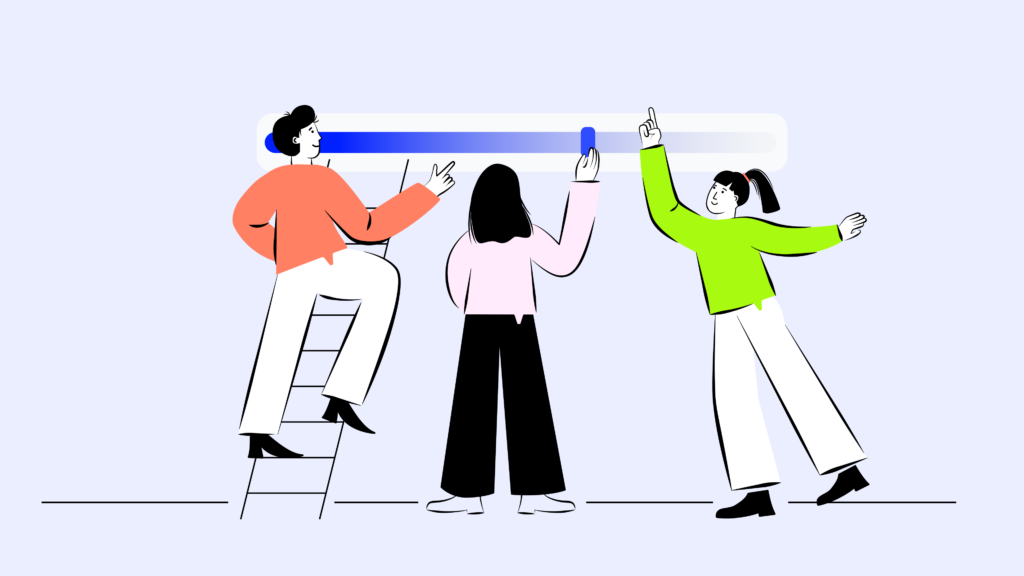How to Raise Customer Satisfaction as an SMB in 2025

An age-old adage goes, “Customer is King”. Nowadays, that saying might even be more true than it used to be. As markets grow, attention spans decline, and customer expectations grow, customer satisfaction (CSAT) scores quickly become the best metrics for revenue growth. And if you’re still skeptical, we’ve got the stats to prove it.
- According to HubSpot, 93% of customers are more likely to make repeat purchases with companies that offer excellent customer service.
- Zendesk found that around 80% of consumers say they would instead do business with a competitor after more than one bad experience.
- Bain and Company claim that increasing customer retention rates by just 5% can increase profits up to 95%.
But knowing this won’t do you much good if you can’t increase your CSAT. So, in this article, we’ll dive deep into what makes your customers tick and how you can use this knowledge to raise customer satisfaction as an SMB.
The Importance of Customer Satisfaction for Small Businesses
But before we deliver on those promises, one question bears explaining first: Why should you, as a small business owner/manager, care? We’ve already shown that CSAT is an essential metric for companies of all sizes. But the reality is it’s even more important for SMBs.
Why? Several reasons, actually. Namely, these include:
- Customer Acquisition Costs: Naturally, SMBs have less money to throw around than their mid-to-enterprise size counterparts, so every cent counts – especially in these economically uncertain times. According to Huifiy, onboarding a new customer costs up to 5x as much as retaining them.
Therefore, persuading your existing client base to stay with you instead of opting for a competitor is an excellent way of saving money to invest elsewhere and can mean the difference between success and bankruptcy.
- Advertising: Marketing and advertising aren’t cheap. But statistics suggest that word of mouth drives up to $6 trillion in consumer spending and constitutes 13% of sales. All for the low, low price of completely free. So, you save even more money by keeping your customers happy.
Furthermore, word-of-mouth advertising is estimated to perform 400x better per impression than traditional marketing channels (PPC, social media ads, etc.). This is especially vital for local and niche companies, which can’t afford experienced link-building companies or extensive advertising, or won’t see meaningful results from it. - Reputation: In the same vein, if you operate in a highly competitive environment, your reputation (ex., Google Reviews) can greatly influence your performance. Big companies can sometimes outweigh these via convenience, being a monopoly, or otherwise. Small businesses rarely have this benefit.
Although not identical to word of mouth, online customer reviews and testimonials also prove your legitimacy and high quality of service and are a valuable resource for the entirety of your sales funnel.
How to Raise Customer Satisfaction as an SMB
It’s time to deliver on what we promised. But we won’t bore you with the obvious tips like “Provide Quality Products and Services”. Instead, let’s focus on 5 actionable ways to raise customer satisfaction as an SMB.
- Personalize Your Way to Success
The sad reality is that most companies view customers as nothing more than walking wallets. Well, people pick up on this fairly quickly, and unsurprisingly, they’re not big fans.
To be fair to mid-to-enterprise-size companies, it can be tough to personalize a customer journey for so many people. But that’s where your strength as an SMB lies. Within a niche market and with a clearly defined client base, you can efficiently cater to your customers.
And nowadays, getting started couldn’t be easier. Advancements in chatbots and automation let you create personalized greetings easily, and just addressing your customers by their first names demonstrably improves engagement.
If you want to go the extra mile, you can apply personalization for your entire sales funnel and create a brand language that your customer base understands and enjoys. Apply it to your designed landing pages, blogs, and emails, and use it to communicate your benefits…
The options are nearly endless, and so are the positive effects you can expect.
- Streamline the Customer Journey
Company owners and managers are often burdened with the curse of knowledge – they understand how their site, products, and services work and expect clients to do the same. Unfortunately, things are rarely as simple and self-explanatory as we’d like to imagine.
Even a single rogue click or inefficiently worded CTA can throw off a buyer’s whole groove, leading them to abandon the shopping cart, sign-up page, or whatever else you’re trying to pitch them.
The goal is simple – create pages that don’t overwhelm and confuse customers. If you feel you can’t adequately evaluate your website, ask for customer feedback, let a designer assess it, or dive into your analytics and look for high bounce rates and unexpectedly long times spent on pages where (you think) there’s no reason to.
Incidentally, this also applies to other aspects of your business. For example, imagine you’re a B2B SMB, and instead of shopping carts, do business via invoices. You can lower the time it takes your customers to pay you by creating clear designs for your invoices and enabling instant card payments.
- Promote Efficient and Friendly Customer Service
Although we’ve mentioned chatbots and automation, it’s important not to forget the importance of human interaction – especially when it comes to solving complex customer issues or pacifying disgruntled clients.
Few people can effectively deal with similar difficult situations. Fewer still enjoy it. But it can only be achieved if you’re willing to give the time of day to train your customer service team. They need to be able to listen first, respond with empathy instead of anger, and still say “no”, when there’s no other option.
And this process doesn’t even have to be expensive. There are endless online resources available to help your coaching efforts, like this guide on How to Provide Excellent Customer Service.
- Let Clients Choose Their Preferred Communication Channel
Different have different ways they like to solve their issues. Some like to hop onto a call, others prefer shooting a message, and others still want to give it a shot by themselves. The harsh truth is that you need to accommodate all these needs if you want to have a great customer experience, even as a small company.
For that reason, you need to cover all your bases. Try to find an affordable calling solution for your conversationalist customers (ideally with an SMS option), grow your influence across social media channels your clients are likely to use (i.e., Facebook, LinkedIn, Instagram), and also make sure to create plenty of self-service options (FAQs, IVR, online knowledge-base, YouTube tutorial videos, etc.)
- Listen to Your Customers
Few things can build a good rapport with people as actually listening to their opinions. To that end, you need to be active on your online review portals (i.e., Google Reviews, G2, TrustPilot, etc.).
If someone slips through the cracks or doesn’t reach out to your customer service and just decides to leave a bad review, you need to strike while the iron’s still hot. Respond to their concerns, offer reimbursement to offset their bad experience (where relevant), and update your clients on changes you’re making to your business via newsletters.
All in all, just treat your customers with the respect they deserve, and you’ll soon see the difference it makes.
What Influences Customer Satisfaction?
Increasing customer satisfaction isn’t an open-and-shut task. There are numerous aspects of your business that influence how your customers feel about you.
However, there are five things you should keep an eye on specifically.
- Quality of Products & Services,
- Customer Service,
- Convenience & Accessibility,
- Pricing & Value,
- Brand Reputation & Image.
While online articles and statistics (like the ones at the start of this article) tend to highlight the importance of customer service and experience, it’s important not to make the mistake of assuming that’s all that matters. Customer satisfaction is a combination of the complex interplay between all five aspects mentioned above. In the next few sections, we’ll show you how to use that fact to your advantage.
How to Measure Customer Satisfaction
Before you start improving your customer satisfaction with the tips we promised, getting a good idea of where you currently stand with your customers is best. This can be achieved in five simple steps.
- Choose Your Preferred Tracking Metric
First, you should know that customer satisfaction score can be tracked by three separate metrics – NPS, CSAT, and CES. Although they all can offer invaluable information regarding client happiness, each approaches the subject slightly differently.
Below, we explain each of these metrics in more depth. We recommend you choose the one that best fits what you want to focus on improving (i.e., overall happiness, willingness to promote, or ease of buying process).
1.Net Promoter Score (NPS): NPS is a widely used metric to measure customer loyalty and satisfaction. It is a single number that ranges from -100 to 100 and is calculated based on the responses to a single question: “How likely are you to recommend our product/service to a friend or colleague?”
The NPS is calculated by subtracting the percentage of detractors (customers who respond with a score of 0 to 6) from the percentage of promoters (customers who respond with a 9 to 10).
2.Customer Satisfaction Score (CSAT): CSAT is a simple and effective way to understand how well a business meets customer needs and expectations. The CSAT score is calculated by asking customers to rate their satisfaction with a particular interaction, product, or service on a scale of 1 to 5 or 1 to 10.
Analyze the responses and calculate the average score by adding up all the ratings and dividing them by the total number of responses. Then, all you need to do is interpret the results into a percentage.
3.Customer Effort Score (CES): CES is a metric that measures how easy or difficult it is for customers to interact with a business or complete a task, such as making a purchase or resolving an issue. It is a single-question metric that asks customers to rate their experience based on the level of effort required on a scale of 1 to 5 or 1 to 7.
Like with CSAT, analyzing your CES is as easy as averaging the scores, dividing them by the number of responses, and converting the result into a percentage. This will tell you how difficult (or easy) your purchase process is for your customers and inform future decisions in terms of CX and support.
- Select a Group of Customers to Survey
The size and composition of your survey group are largely up to you, and you can ask for feedback from people who have recently done business with you or even your entire customer base. Just be prepared that only a percentage of the people you ask will answer.
However, you can boost your survey response rate by offering incentives, like discounts, gift cards on future purchases. Incidentally, this also serves to increase your customer satisfaction as a whole.
- Send Out Your Survey
The next step is simple. All you need to do is choose the channel your survey group will most likely be receptive to (i.e., email, SMS, social media, in-app, etc.) and hit “send”. Then, give your customers some time to respond, collect the answers, and…
- Average and Interpret the Results
Follow the information given in the description of your selected metric. Based on the results, you’ll be able to better understand your customers’ feelings towards your company. Furthermore, depending on the metric you chose, you can establish which aspects of your business require the most attention.
If your findings are inconclusive, you can always go back and create another survey with another group and measure one of the other customer support metrics. Alternatively, just create a survey that takes into account all of them, and get a comprehensive view of your customer satisfaction that way.
- Get to Work Improving
Congratulations, now you should have a good idea of your standing with your customers, as well as what you should focus on improving first. But once you’re done patting yourself on the back, you can roll your sleeves back up because this is just the first step. Next, you’ll need to address your clients’ feedback and start tweaking your customer journey using task management tools that help organize and track tasks related to customer journey improvements and ensure that nothing falls through the cracks.
The Bottom Line
Customer satisfaction is quickly becoming one of the most important metrics for companies to track, especially SMBs, who can’t afford to outspend their competitors. Thankfully, there are many ways you can improve your NPS, CSAT, and CES metrics without breaking the bank.
Just remember to be strategic in your approach, don’t be afraid to get your hands dirty and rework your business processes from the ground up if necessary, and most importantly, be good to your employees and customers. But also don’t forget that good employee communication is a must. You won’t have to wait long for the improvements after that.
What did you find in this article?
How can a small business achieve customer satisfaction?
1. Know their customers by gathering feedback through surveys, social media, or customer service interactions.
2. Provide excellent customer service by ensuring well-trained staff who can handle inquiries and complaints professionally.
3. Offer quality products or services that meet or exceed customers’ expectations.
4. Be responsive by promptly addressing any issues and keeping customers informed.
5. Build long-term relationships by offering loyalty programs,
personalized customer care and communications with incentives.
Provide value by offering quality products or services at a fair price.
What is customer satisfaction in small businesses?
Customer satisfaction in small businesses refers to how happy customers are with the products or services provided by the business. It is important for small businesses to provide good customer service, high-quality products or services, and address customer feedback and concerns to improve customer satisfaction.
What are the 3 C’s of customer satisfaction?
Consistency: Consistently meeting or exceeding customer expectations is essential to achieving high levels of customer satisfaction.
Communication: Effective communication with customers is important in understanding their needs and concerns, and addressing them in a timely manner.
Care: Demonstrating that the business cares about its customers and values their feedback is crucial in building trust and loyalty, which ultimately leads to higher levels of customer satisfaction.
Why is customer satisfaction important for a small business?
Customer satisfaction and CSAT measurement is important for small businesses because it leads to customer loyalty, positive word-of-mouth referrals, competitive advantage, increased revenue, and cost savings. It helps small businesses to maintain a strong and sustainable customer base and stay ahead of their competitors.
What are the 5 levels of customer satisfaction?
Very Unsatisfied: When a customer is extremely dissatisfied with the product or service provided.
Unsatisfied: When a customer is dissatisfied with the product or service provided.
Neutral: When a customer is neither satisfied nor dissatisfied with the product or service provided.
Satisfied: When a customer is pleased with the product or service provided.
Very Satisfied: When a customer is extremely pleased with the product or service provided thanks to pleasant customer experience, product usability and quality and so on.
What is the KPI for customer satisfaction?
The KPI (Key Performance Indicator) for customer satisfaction is typically measured through surveys or feedback mechanisms, such as Net Promoter Score (NPS) or Customer Satisfaction Score (CSAT). These metrics help businesses to quantify and track customer satisfaction levels over time and identify areas for improvement.
























